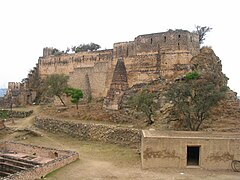Ramkot Fort
| Ramkot Fort | |
|---|---|
 View of Ramkot Fort | |
 | |
| General information | |
| Location | Dadyal,Mirpur district,Azad Jammu and Kashmir |
| Construction started | 16th century AD |
Ramkot Fort(Urdu:قلعہ رام کوٹ,romanized:Qila Ram Kot) is a medieval fort inMirpur,Azad Kashmir,Pakistan.[1][2]The fort is accessible via three routes from Dina, Dadayal, and Mirpur, with 440 stairs leading to the main gate, which is built on a sloped rock for defensive purposes.[3]
History
[edit]The original fort was constructed in 1186 during theGhurid dynastybySultan Ghiyas-ud-din,according to the information board at the entrance but that fort is no longer in existence.[3]In the late 14th century, the fort was under control ofJasrat,a Punjabi Khokhar chieftain. At this fort Khokhars clashed with the armies of amirTimurin 1398.[4]However, the current structure probably dates to the 16th century builted byKashmir Sultanate.[5][6]
A temple with a large redShivalinga,brought from theGanges River,suggests a significant Hindu population once resided in the area.[3]The presence of Hindu mythological figure Ram Chandra's birthplace in nearbyPharwalamay explain the fort's name.[3]However, British geologist and historianFrederick Drewattributes the fort's construction to aGakharnamed Taghlu, contradicting the information board.[3]The fort underwent renovation during the reign of Gakhar Queen Mango, whose daughter married Mughal emperorAurangzeb Alamgir's son.[3]During theSikh era,the fort was handed over to theDogras.[3]
Ramkot Fort held strategic importance, as one of the four ancient routes to Srinagar passed through it.[3]The nearbyMangla Fort,attributed to Queen Mangla, daughter of KingPorus,is closely associated with the famous battle betweenRaja PorusandAlexander the Greatin 326 BC.[3]The area is also significant for being the birthplace ofRaja Porusin 400 BC and, much later, Mian Muhammad Bakhsh, author of Saif-ul-Malook.[3]
Architecture
[edit]The main gate, constructed with red bricks, contrasts with the stone used elsewhere, suggesting possible destruction and reconstruction.[3]A smaller gate at the back was likely used for escape.[3]
The fort's interior features two large ponds for rainwater collection, essential due to its elevation and previous location at the confluence of the Jhelum and Poonch rivers.[3]Collapsed rooms, raw iron deposits, and the superintendent's residence are found within the complex.[3]The fort also includes a slope for hauling cannons, with a donated cannon on the rampart.[3]
Gallery
[edit]-
Landscape view
-
Bird's eye view
-
Courtyard
See also
[edit]- List of UNESCO World Heritage Sites in Pakistan
- List of forts in Pakistan
- List of museums in Pakistan
References
[edit]- ^"Fort forlorn and forsaken | Footloose".The News International.
- ^"Ramkot Fort: Centuries-old Kashmiri heritage site on the verge of destruction".The Express Tribune.January 29, 2012.
- ^abcdefghijklmno"منگلا ڈیم کے قریب رامائن کے رام چندر سے منسوب قلعہ"[Fort attributed to Ram Chander of Ramayana near Mangla Dam].Independent Urdu.February 19, 2021.
- ^Panikkar, Ayyappa(1997).Medieval Indian Literature: Surveys and selections.Sahitya Akademi. p. 72.ISBN978-81-260-0365-5.
- ^Ali, Aown (July 3, 2015)."Ramkot Fort: The crumbling giant of Azad Kashmir".DAWN.COM.
- ^"Ramkot Fort, Mirpur, Pakistan".Asian Architecture.




